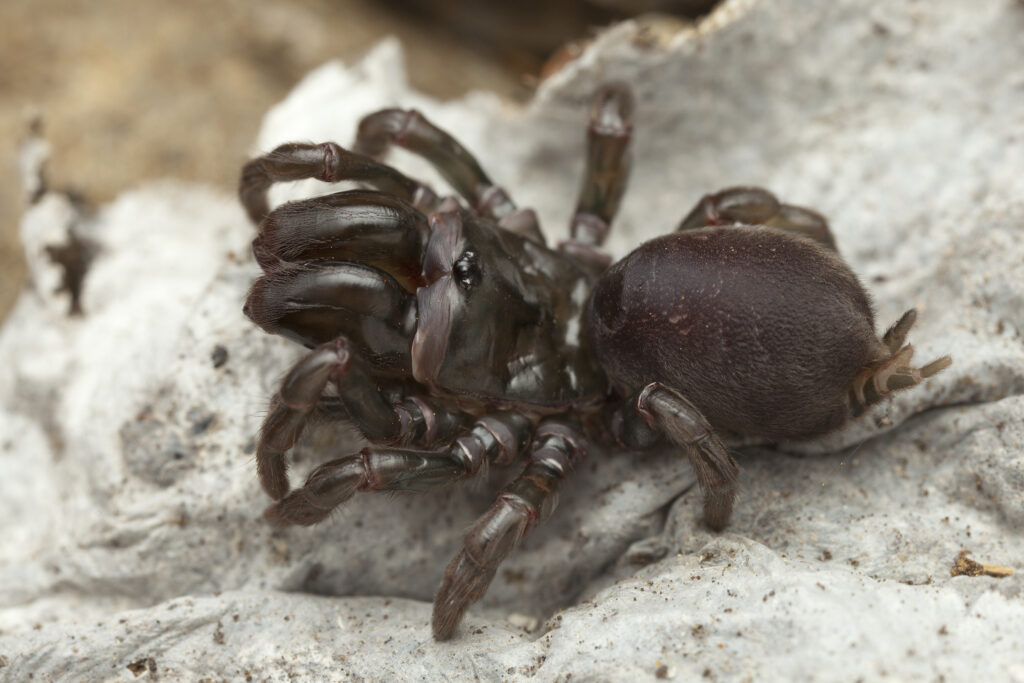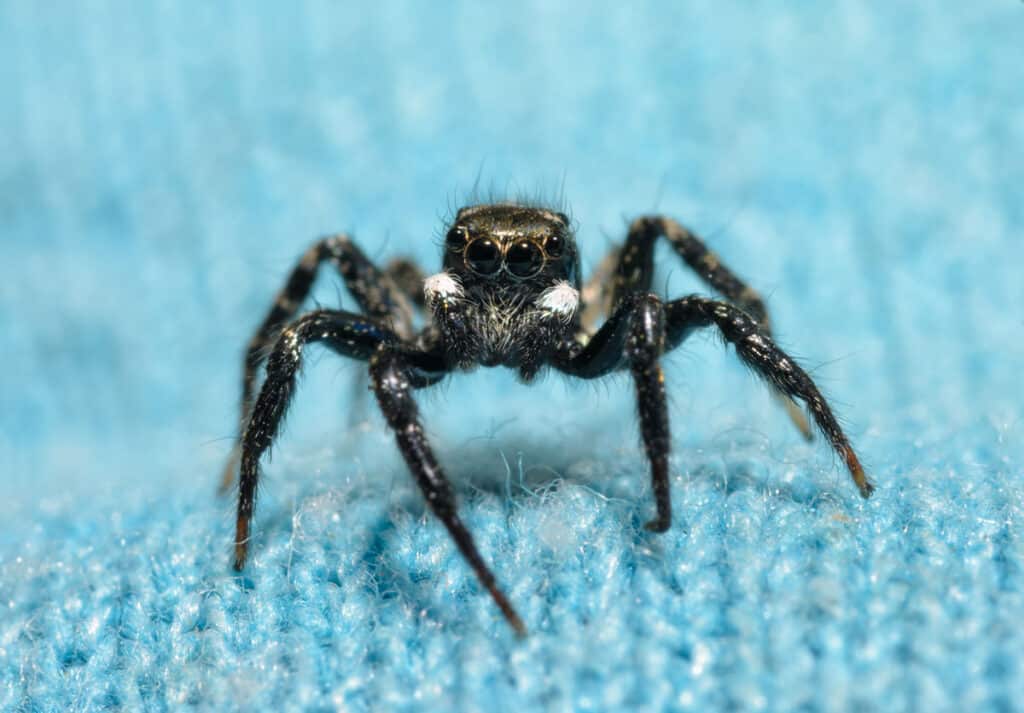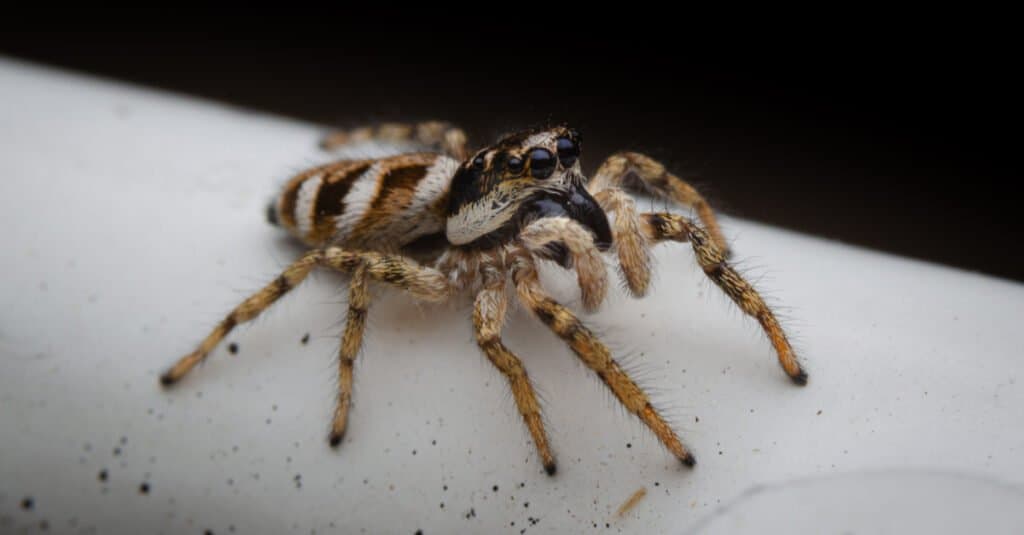The sight of black spiders crawling around Georgia can cause concern for many arachnophobes. Spiders are known for their eight legs, their sometimes-creepy appearance, and their ability to produce fascinating silk webs. But are black spiders in Georgia dangerous?
You’re in the right place if you’re curious and want to learn more about spiders. In this article, we’ll take a closer look at some of the most common black spiders in Georgia and explore their behavior, habitat, and level of danger.
Eastern Parson Spider (Herpyllus ecclesiasticus)

Its front body segment tends to be a chestnut hue. The abdomen features a grayish tint with a unique white or pink marking along its center.
©Fyn Kynd from Searsmont, Maine, United States / CC BY 2.0, via Wikimedia Commons – License
The first recorded sighting of the eastern parson spider in the state of Georgia was in 2013. This spider is found throughout the eastern and central regions of the United States and throughout Southern Canada.
Ranging from brown to black, the eastern parson spider typically measures around half an inch in length. Its front body segment tends to be a chestnut hue. The abdomen features a grayish tint with a unique white or pink marking along its center. Delicate hairs cover the body, creating a soft and velvety texture.
To avoid predators, this spider will move back and forth in a zigzag pattern, making their capture difficult. During the fall, females deposit a white egg sac beneath the bark of trees and logs. Here, they hibernate and guard the sac against predators.
Wooded regions, as well as areas underneath stones or tree bark, are typical habitats for the eastern parson spider. However, they may also be found in homes, often clinging to walls or ceilings.
These spiders are known to prey on other spiders, with a particular preference for wolf spiders. However, they will consume any type of spider they come across, as well as various insects.
Is the Eastern Parson Spider Dangerous?
They are one of the few spiders capable of penetrating human skin. Some people may develop localized swelling and itching following the initial pain of a bite.
Fun Facts
- Eastern parson spiders tend to move in groups and mate throughout the year.
- Rather than building webs, these spiders create silken sacs to rest in.
- Eastern parson spiders are capable of swift movement, particularly while hunting prey.
Southern Black Widow (Latrodectus mactans)

The female is usually larger than the male, measuring up to 1 and a half inches long with legs extended.
©Jeff W. Jarrett/Shutterstock.com
Georgia is home to southern black widows, which are known for their venomous bite.
These spiders have a glossy black body with a distinctive red hourglass-shaped marking on their abdomen. The female is usually larger than the male, measuring up to 1 and a half inches long with legs extended. Meanwhile, the male southern black widow is much smaller, measuring half the size of a female.
The female is more aggressive than the male and may attack if provoked or disturbed. Females also tend to be territorial and will defend their webs and eggs sacs against any perceived threats. Males are usually harmless.
During the daytime, southern black widows typically hide in dark and sheltered places, such as under rocks, woodpiles, or debris. They come out at night to look for food. These spiders consume a diverse range of insects, including chilopods, diplopods, woodlice, and other arachnids as well.
Is the Southern Black Widow Dangerous?
The southern black widow is a venomous spider and can cause harm to humans. However, the amount of venom that the female injects during a bite is usually small. As a result, death is a rare occurrence. According to reports, human mortality from black widow spider bites is well under 1%. Symptoms include pain and swelling in the affected area, muscle cramps, spasms, fever, chills, nausea, vomiting, and difficulty breathing.
Fun Facts
- The web spun by the southern black widow is both strong and sticky.
- The digestion process of the spider’s prey takes place outside of the spider’s body.
- Mating for southern black widows usually occurs during the summer or spring.
Black Purseweb Spider (Sphodros niger)

One of the most prominent features of the black purseweb spider is its chelicerae or fangs.
©Pavel Krasensky/Shutterstock.com
The black purseweb spider has a striking appearance that many people may find intimidating or frightening. One of the most prominent features of the black purseweb spider is its chelicerae or fangs. Unlike other spider species, these fangs are distinctly visible at the front of the spider’s body.
Despite its small size, which is about the size of a penny, the spider’s striking black coloration makes it easy to spot.
Most of the time, the black purseweb spider lives inside a cylindrical tube that it weaves. The spider buries the majority of the tube and its web underground. It disguises the above-ground portion with various materials such as twigs, leaves, and debris. Due to the spider’s adeptness at hiding its tube, it can be challenging for scientists to observe its behavior. In fact, this species is somewhat of a mystery.
The black purseweb spider inhabits damp woodlands and occasionally swamps or open woods within tropical to temperate climates. Being predators, these spiders primarily prey on insects, smaller spiders, and other similar creatures.
Is the Black Purseweb Spider Dangerous?
These spiders have the potential to bite humans if they are mishandled. However, their bites do not typically pose a significant threat unless the person is highly sensitive to spider bites.
Fun Facts
- The black purseweb spider can be difficult to spot as it can be quite elusive.
- Only male pursewebs have been observed crawling out of their tubes.
- Black purseweb spiders typically give birth to between 50 and 80 spiderlings at a time.
Twinflagged Jumping Spider (Anasaitis canosa)

Twinflagged jumping spiders can be observed in various locations, such as in leaf litter, on forest floors, or atop this bright blue sweater.
©Sari ONeal/Shutterstock.com
The twinflagged jumping spider is a species that is widely distributed throughout the Southeastern United States. Georgia has a significant population.
The cephalothorax of the small twinflagged jumping spider is mostly black, with two or four white marks. While there are some variations in appearance among individuals, certain features are consistent across the species. For example, the abdomen comes to a pointed tip and contains a central white dash. Encircling the dash is a large, possibly faded, white ring that may be interrupted by light-colored chevrons. These patterns stretch from the dash to the end of the body. In contrast, the legs are lighter in color and have dark bands.
Adult twinflagged jumping spiders are 0.15 to 0.4 inches long.
These spiders have an exceptional hunting technique for capturing ants that is both instinctive and unique. The spider will orient itself toward the ant, then move in an arcing motion until the ant is facing it. Once it has the ant’s attention, the spider will leap and attack, piercing the top of its head or body.
Twinflagged jumping spiders are highly active. They can be observed in various locations such as leaf litter, forest floors, rocks or stems of plants, and decks. Its diet primarily consists of insects like flies, moths, and crickets.
Is the Twinflagged Jumping Spider Dangerous?
This spider is capable of biting, but its bite is not venomous, and it is not a dangerous species.
Fun Facts
- The twinflagged jumping spider does not spin webs to catch its prey.
- At times, it may enter homes while searching for food.
- Its remarkable jumping ability helps the spider avoid potential threats.
Black and Yellow Garden Spider (Argiope aurantia)

In an interesting behavior, males often hold their front and hind legs tightly together, creating a St. Andrew’s cross-like silhouette.
©iStock.com/AwakenedEye
This striking spider species found in Georgia is known for its impressive appearance. Female black and yellow garden spiders can reach a length of slightly over 1 inch. Their male counterparts are notably smaller in size. The third set of legs on these spiders is approximately half the length of the other two pairs.
In an interesting behavior, males often hold their front and hind legs tightly together, creating a St. Andrew’s cross-like silhouette. The body segment where the legs and mouthparts connect is adorned with small, shiny, white scales. Lastly, the abdomen is distinctively egg-shaped and adorned with black and yellow markings.
The habitats of these spiders are generally gardens and grassy areas near residential homes, as well as in tall grasslands. Their primary source of sustenance consists of insects. However, they may also consume slightly larger prey, such as small lizards that become ensnared in their webs.
Is the Black and Yellow Garden Spider Dangerous?
The black and yellow garden spider is generally not aggressive toward humans, and bites from this spider are rare. Nonetheless, the spider’s bite contains a potent neurotoxic venom. This is primarily used as a defense mechanism against predators and will only feel like a bee sting to humans.
Fun Facts
- These spiders detect their prey through vibrations in their webs.
- They tend to reuse the same web for several months, ensuring it is properly maintained each night.
- These spiders are a valuable asset to gardens, as they can effectively manage pest populations.
Zebra Spider (Salticus scenicus)

They are named after their black and white stripes, a distinctive characteristic that makes them easy to identify.
©Mario.Pieper/Shutterstock.com
The zebra spider is a small spider that can be found in Georgia. Males typically measure between 0.20 to 0.24 inches, while females can grow up to 0.20 to 0.35 inches in size. They are named after their black and white stripes, a distinctive characteristic that makes them easy to identify. These tiny spiders have round bodies and are covered in white hairs that form stripes.
Zebra spiders are known to feed on smaller spiders and other arthropods, as well as larger prey items. They have been observed devouring mosquitoes that are almost twice their length. Additionally, they eat small species of moth, which can be up to three times the length of the spider.
Similar to other jumping spiders, they use their large front eyes to spot and follow their prey. They ultimately capture it by leaping onto it.
These spiders are commonly found in open habitats such as shingle beaches, rock faces, and sometimes on tree trunks. They are naturally inclined to live in open, vertical environments. They are often found in close proximity to humans in urban settings, such as on walls and garden fences.
Is the Zebra Spider Dangerous?
The likelihood of these spiders biting humans is low. They only bite in self-defense or when they are provoked by being handled. Although they use venom to immobilize their prey, the impact of their venom on humans is minimal due to the spiders’ small size.
Fun Facts
- The spider is capable of jumping up to around 4 inches, which is over 14 times its own body length.
- Females create a silk cocoon to protect their eggs, and they guard the nest until their young hatch.
- With over 5000 spiders, the Salticidae family is the largest family of spiders in the world.
The photo featured at the top of this post is © Wildsmith_Westwood/Shutterstock.com
Thank you for reading! Have some feedback for us? Contact the AZ Animals editorial team.






